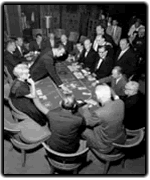The History of Baccarat
Baccarat History
 People of all classes, from many countries, have been playing some form of baccarat for centuries. One medieval form of the game was played with tarot cards. In Italy, the game can be traced back as early as 1490. The very name of the game baccarat comes from “baccara,” the Italian word for zero (the value of face cards and tens). During the reign of Charles VIII of France (1483-1498), the game spread across the border to France, where its popularity continued to grow. Eventually it became a favorite among the French nobility.
People of all classes, from many countries, have been playing some form of baccarat for centuries. One medieval form of the game was played with tarot cards. In Italy, the game can be traced back as early as 1490. The very name of the game baccarat comes from “baccara,” the Italian word for zero (the value of face cards and tens). During the reign of Charles VIII of France (1483-1498), the game spread across the border to France, where its popularity continued to grow. Eventually it became a favorite among the French nobility.
As the game became established in France, the its terminology changed. Perhaps most noticeable was the change of its name “Baccarat” to “Chemin de Fer” (“street of fire”). The French also introduced their own phrases for some actions in the game: “banco,” “non,” “cheval,” and “carte.”
Baccarat never seems to grow old in Europe, despite the introduction of other games and the passage of time. It remains one of the most popular games in casinos there. In America, however, it has never managed to surpass blackjack in popularity, though most American casinos do have baccarat tables.
Attempts have been made to market Baccarat as glamorous and classy, evoking its history as a pastime of the French nobility. Frank Sinatra was one of the people responsible for this new image of baccarat. In the 1950’s, he was a co-owner of the Sands Casino in Las Vegas, a paradise for high rollers – complete with special roped-off areas dedicated to baccarat and dealers in tuxedos. Other casinos in Nevada followed suit by setting off baccarat areas that were closely monitored and sometimes even guarded. 
To add to baccarat’s glamorous image, American casinos also adopted the aristocratic French terms for plays in the game: “Banco,” used when a player bets all the funds of the bank, and other bets are withdrawn; “Cheval,” when players are able to bet on the banker’s or player’s hand; “Non,” when the player chooses to stand on the hand; and “Carte,” when the player wants another card. All of these terms are still in use today.
Not all players are high rollers, though, and the casinos recognized that possible players might be intimidated by the elegant, set-off surroundings filled with guards and rich gamblers. To expand baccarat’s appeal , American casinos introduced mini-baccarat, a smaller version that is played on a blackjack-sized table. This new version has only one dealer. The layout of mini-baccarat is the same as classic baccarat, with seven numbered positions, and options that allow bets for the banker, the player, and a tie. However, mini-baccarat is more informal and usually has fewer players at a time. It’s a perfect version for those who might not be familiar with the game, or don’t want to bet as much.
American baccarat had its origin in Havannah, Cuba. It may never rival blackjack in terns of popularity, but baccarat’s appeal to the high roller, and mini-baccarat’s appeal to the novice, ensure its presence in American casinos for many years to come.
Baccarat Tips | Baccarat Strategy | History of Baccarat | How to play baccarat
LINK TO THIS PAGE: